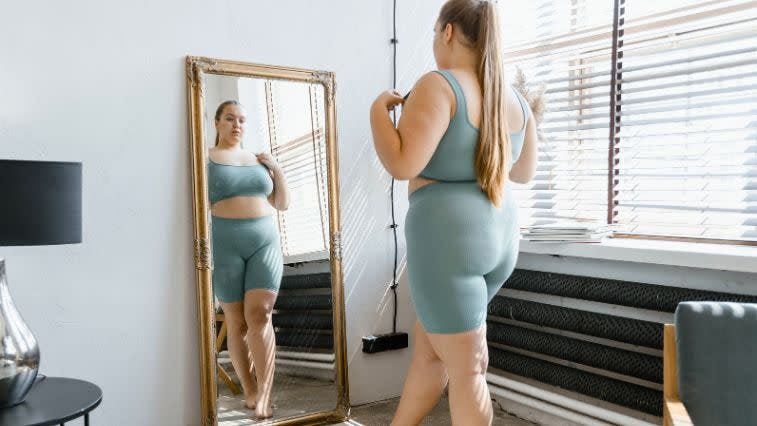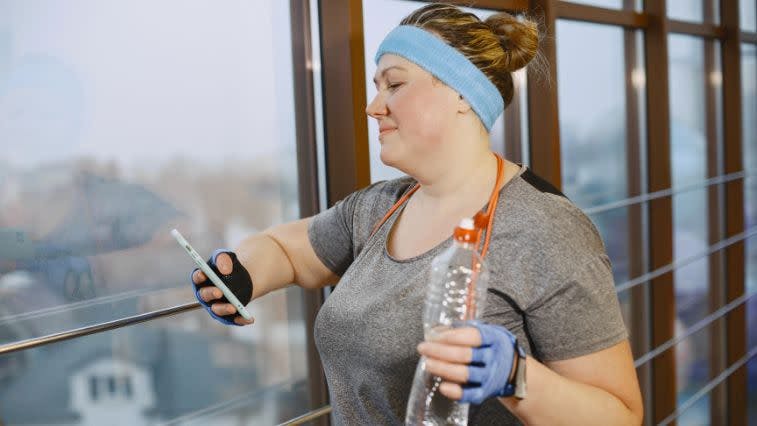Hate Stepping on the Scale? Track Your Progress These Ways Instead
Our content strives to support, inform, and motivate you to meet your health goals. We want to be your trusted source of expert- and science-backed info dispensed in simple, actionable ways. Read our Editorial Guidelines.
Let’s be honest. Losing weight is a challenging (and oftentimes incredibly frustrating) process, but tracking your progress doesn’t have to be.
Monitoring progress is one of the most useful practices you can implement to reach your weight loss goals. It tells us whether or not our approach is working.
And what better way to track your weight loss progress than a scale, right? Not necessarily!
The scale is not the only way to do this. In fact, it’s often not even the best choice.
Through years of testing various tracking methods with my clients as well as myself, I’ve learned that while the scale can be an effective tool, it’s not the best fit for everyone. It alone doesn’t provide a comprehensive picture of progress.
In this article, I’ll explore four non-scale tracking tools that I use as a trainer to help my clients achieve their weight loss goals. But, first, let’s discuss why the scale is often insufficient.
What’s Wrong With the Scale?

Have you ever looked in the mirror and noticed some muscular definition that wasn’t there before, or slipped on jeans to feel them fit a little looser… only to step on the scale to find that you’ve somehow gained weight?
That’s because the scale doesn’t tell the whole story.
One of the biggest shortcomings of the scale is that it doesn’t differentiate between fat and muscle mass. In short, you can lose body fat and achieve a slimmer figure but still weigh the same (or more).
Have you ever seen your weight jump several pounds overnight? That’s because your body weight is incredibly prone to fluctuation. It’s far more likely that your last meal is still working its way through your digestive system.
And for many, the number on the scale elicits an emotional response that can have profoundly negative impacts on their mental health and perception of self-worth. Hyper-fixation on this one measure can detract from other measures of success and obscure the reality of their progress.
The research on the effectiveness of self-weighing and its effect on weight loss is mixed. One randomized controlled trial of 92 participants didn’t find any evidence that frequent weigh-ins were associated with greater weight loss.
Other research shows that it can be effective in promoting weight loss, especially when used in conjunction with other tools administered correctly and safely.
Here are a few tips if you do choose to use the scale:
Weigh yourself first thing in the morning before you’ve eaten or drunk anything, and after you’ve used the bathroom
Use the same scale every time
Save yourself the frustration of weighing yourself when you know it won’t be accurate (i.e. during your menstrual cycle, after a big meal, after a night of drinking)
Try weighing every 1–2 weeks rather than daily
If you wish to weigh yourself daily, take a weekly average of your weigh-ins and track your weekly averages
If you’re struggling with scale anxiety, try using the free app Happy Scale (a huge hit with my clients)
Don’t let one silly number dictate your self-worth (you are more than just a number!).
The truth is there are many other indicators aside from body weight that reflect success toward a weight loss goal. The alternatives provide particularly useful insights and nuance that the scale just can’t offer.
Let’s get into these amazing tools.
Progress Pictures

Taking progress pictures, also called “before and after pictures,” is one of the best options for tracking progress because it’s free and super easy to do. In my opinion, it’s a no-brainer.
By placing the original pictures side-by-side with current pictures, you can easily detect changes in body composition. You might notice some new muscular definition, slimming of certain areas, or changes in face shape.
While this tool is easy to implement, consistency between two sets of pictures is key to its effectiveness.
Here are some guidelines to follow:
Take your pictures at the same time of day each time (preferably, first thing in the morning before you’ve eaten or drunk anything, and after you’ve used the bathroom).
Use a plain white backdrop.
Wear minimal clothing (i.e. undergarments or a bathing suit) and use the same or similar clothing each time.
Center the camera at eye level and keep the framing of your body consistent.
Keep poses consistent and your body relaxed. I recommend the following shots:
Front #1: arms by your side
Front #2: hands on hips (on or just below hip bones)
Side #1: arms by your side (make sure to face the same way each time)
Side #2: arms outstretched forward, parallel to the ground (like a zombie)
Back #1: arms by your side
Back #2: hands on hips (on or just below hip bones)
Take a new round of pictures every 1–2 months.
I have found this method particularly helpful when a client’s scale reading doesn’t match up with the changes I see. The pictures will often reveal changes in body composition that were not reflected on the scale.
Circumference Measurements
Another way to measure progress is by tracking changes to the circumference of various areas of your body. All you need is a tape measure and someone to take the measurements for you.
One study found circumference measurements to yield similar body composition results to the highly regarded DEXA scan.
If you’re looking for a super easy and cheap tracking tool, this one’s for you. Record the measurements monthly to see which areas are shrinking. Here’s how it works.
Keep in mind that this method is subject to human error, so follow these tips to ensure consistency.
Measurements should be taken:
About once a month
On the same side of the body each time
By the same person every time
Several times, then averaged
In similar conditions each time (i.e. time of day, clothing, hydration)
2. Don’t exercise beforehand.
Body Fat Percentage
Body fat percentage is an even stronger indicator of progress than body weight. At the end of the day, loss of body fat is really what you’re looking for. And there are several different ways to measure it.
Skinfold caliper
The cheapest way to get body fat measurements is with a skin caliper. You may remember using these in grade school gym class — that pinching device that measures fat content by separating the fat from muscle.
One study showed similar results between skinfold measurements and the far less accessible Bod Pod device. Here’s how it works!
As a trainer, I measure the tricep, umbilical, suprailiac, and thigh sites. Once you have these four numbers, plug them into this four-site calculator to determine your body fat percentage.
Similar to the circumference measurements, vulnerability to human error is a concern. These are tiny measurements, so it is critical that you take each measurement multiple times and take the average.
Regardless of how precise your measurements are, you’ll still be able to detect relative change over time as long as you keep your measurements consistent. I recommend following the same tips from the section on circumference measurements to achieve this kind of consistency.
And check out the skin caliper I recommend to my clients; it’s only $7 and comes with a tape measure. This has been a huge success with my clients, as it often reveals changes in body composition that the scale can’t provide.
Bioelectrical Impedance Analysis (BIA)
BIA devices send small electrical currents through the body to measure body composition. While it’s more expensive than a skinfold caliper, it’s the easiest and quickest way to track body fat percentage.
This tool usually comes in the form of a handheld device or smart scale. So, you just hold or stand on it for a few seconds and you’ve got your body fat percentage. Easy!
And it’s been found to be pretty effective. A 2018 study found three different commercially available BIA devices to be reliable and valid at measuring body fat percentage.
One of the best things about BIA is that you don’t have to worry about human error. However, you do want to make sure you’re using a quality device that will get you the most accurate results.
Here are a few that I have researched and recommend trying:
Similar to the other metrics, accuracy is heavily influenced by eating, drinking, exercise, menstrual cycle phase, etc. So again, make sure to keep conditions as consistent as possible for the best results.
InBody
The final option for tracking body fat percentage is certainly the least accessible and most expensive, but it’s an awesome tool.
One study found InBody to be comparable in validity to the medical-grade DEXA scan.
This device not only provides your body fat percentage, but also dozens of other useful measurements, such as lean body mass, fat mass, and basal metabolic rate.
A few months ago, one of my clients was disappointed to find that she had gained weight. I advised her to do a new InBody scan, and we were able to see that the weight she had gained came from lean body mass (muscle), and that she had actually lost a bit of fat as well.
While this tool provides results as quickly and easily as a BIA, it has its downsides. To use an InBody, you’ll first have to find a gym or health store that offers public use. And they often charge anywhere from $10–50 for each scan.
If you’re lucky, your gym might have one, but depending on where you live, it may be difficult to find one nearby. Find locations near you.
Behavior Tracking

One highly underestimated and underutilized tool is behavior or habit tracking.
The fuel driving sustainable weight loss progress is the incorporation of positive habits — and the elimination of negative ones. Weight loss can be a slow process, so the importance of building habits that support your goals cannot be overstated.
A six-month study found that monitoring behaviors such as daily steps, physical activity, and food logging enhances weight loss results.
I recommend keeping a journal or spreadsheet of the habits you decide to track. There are many options to choose from, but here are some I frequently use with my clients:
Completing weekly workouts
Meeting a daily calorie or protein target
Completing daily food logs
Meeting a daily step target
Meal prepping
Eating more whole foods
Eating out less
Eating mindfully
Drinking less soda or alcohol
Getting 7–9 hours of sleep
Adhering to a sleep routine.
I recommend starting off with two to three habits, and building on them once you’ve achieved some consistency. Here’s an example of how to record and track these behaviors.
| Mon | Tues | Wed | Thurs | Fri | Sat | Sun | Total |
Worked out | X |
| X |
| X |
| X | 4 |
Met step goal |
| X | X | X |
| X | X | 5 |
Logged food | X | X |
| X |
|
|
| 3 |
Ate out |
|
|
|
| X |
|
| 1 |
Drank alcohol |
|
|
|
| X | X |
| 2 |
Went to bed by 10pm | X | X | X | X |
|
| X | 5 |
Then, you can compare your performance each week to the previous one to see which habits you’ve improved and which ones need more work.
You could also use a habit tracker app such as Kickoff or HabitShare. Many of my clients like that it sends you reminders to complete your daily habits, plus you can share your habits with a coach or friends for extra accountability.
How to Get Started
1.Choose at least two different tools
I recommend choosing at least one numerical method (i.e. scale, circumference, body fat percentage) and at least one non-numerical one (i.e. progress pictures, behavior tracking).
2.Make a schedule
Determine when you will take your baseline measurements and how often you’d like to administer each. Then, make reminders for the next round. Remember, for circumference and body fat measurements, you’ll want to wait at least a month between sessions. Weighing in and behavior tracking can be done daily or weekly.
3.Determine where you’ll track
Get a journal or create a spreadsheet with all the metrics you’ll be tracking. Remember, you can also use apps like Happy Scale and HabitShare.
4.Look at your results as data points
Try to detach emotion from your results. Each number or picture simply helps us determine if we’re on the right track, NOT if we are worthy.
5.Adjust your plan as you go
Use your results to make practical changes. If you aren’t seeing progress in any of your metrics, you may need to adjust your calorie target, increase daily activity, etc.
6.Get help from a pro
If you’re struggling to get accurate measurements or find a system that works for you, schedule a free consultation with a Kickoff trainer, who can help you build and stick to an effective tracking plan.